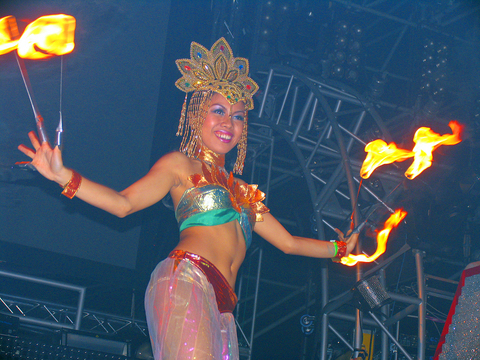The world's most popular DJ is Paul van Dyk and he showed Taipei why with a fierce set of techno-trance music that had the city's bright young things transfixed by the beat until five in the morning.
He played until everyone was satisfied and the DJ box was decked in flowers presented by impressed fans.
Wearing a simple, white, pressed shirt with slacks and looking smooth, Van Dyk set aside the inevitable tiredness of a world tour to promote his latest album Politics of Dancing 2.

PHOTOS: JULES QUARTLY, TAIPEI TIMES
The irritation of a delayed flight meant he only had time to quickly check in at the Grand Hyatt Hotel before being driven to the show at around 1am.
An hour previously the queue outside the venue had a view of the world's tallest building, which provided some distraction for the 3,000 people who were snaking halfway round the Taipei World Trade Center 2 building (
At the entrance security guards had to force the surging crowd back at one point. The atmosphere was charged and a flash point could have set off trouble, but instead people kept their party mood and most managed to get in before 1:30am.

It was a big night for Taipei as smart businessmen and gang leaders insisted on flaunting their connections to jump the queue. Gaggles of their enchanted and enchanting followers trailed in after them.
Loop, the promoter of the event, had spent extra cash on the speakers so the bass rumbled and delivered a huge sound with plenty of roll at low frequency. If more had been paid, perhaps there would not have been times when the bass bins cut out.
Fortunately, there was an entertaining stage show for these lulls -- techno-fetish actors on stilts, dancers, fire spinners -- and Van Dyk used them to rebuild his sound and crash back in again to big cheers when the volume returned. It almost seemed staged, as the DJ pulled the musical strings and brought the crowd up and then let it recharge itself for the next high point.
Since Van Dyk's flight had been delayed there were no interviews, so it was not possible to record what his impressions of Taiwan were, or what car he likes to drive. But looking at his interviews he generally says the same thing. Maybe it's because he mostly gets asked the same questions.
He's 34, from the former East Germany, and lived in Berlin, where he could listen to Western radio stations. His passion for music was ignited by The Smiths and New Order. When the wall came down in 1989 he started playing on the Kreuzberg area techno scene, then moved on to England and now spends a lot of his time in America. He works hard and he doesn't do drugs.
He is top class and plays the tunes middle Europe favors. Most of the voters in the DJ Magazine poll who voted for Van Dyk are from here.
I prefer former number one Tiesto's music, his sense of pace and melody and neat mixes. But right now Van Dyk is putting his rivals in the shade with his almost Wagnerian vibes: his drama and technique.
He writes and produces most of the tracks he plays, but these are tweaked CD singles, or "dub plate" versions, that only he owns. So he can change up his set and respond to a crowd's mood better than anyone else.
As for the Loop promoters, the owners established a relationship with Van Dyk about three years ago when he was invited to play at 2nd Floor.
They too have proved themselves on the world stage and are the natural choice for any big-name DJ rolling into town.
It was a proper rave, on a par with anywhere else in the world.

One of the biggest sore spots in Taiwan’s historical friendship with the US came in 1979 when US president Jimmy Carter broke off formal diplomatic relations with Taiwan’s Republic of China (ROC) government so that the US could establish relations with the People’s Republic of China (PRC). Taiwan’s derecognition came purely at China’s insistence, and the US took the deal. Retired American diplomat John Tkacik, who for almost decade surrounding that schism, from 1974 to 1982, worked in embassies in Taipei and Beijing and at the Taiwan Desk in Washington DC, recently argued in the Taipei Times that “President Carter’s derecognition

This year will go down in the history books. Taiwan faces enormous turmoil and uncertainty in the coming months. Which political parties are in a good position to handle big changes? All of the main parties are beset with challenges. Taking stock, this column examined the Taiwan People’s Party (TPP) (“Huang Kuo-chang’s choking the life out of the TPP,” May 28, page 12), the Democratic Progressive Party (DPP) (“Challenges amid choppy waters for the DPP,” June 14, page 12) and the Chinese Nationalist Party (KMT) (“KMT struggles to seize opportunities as ‘interesting times’ loom,” June 20, page 11). Times like these can

June 23 to June 29 After capturing the walled city of Hsinchu on June 22, 1895, the Japanese hoped to quickly push south and seize control of Taiwan’s entire west coast — but their advance was stalled for more than a month. Not only did local Hakka fighters continue to cause them headaches, resistance forces even attempted to retake the city three times. “We had planned to occupy Anping (Tainan) and Takao (Kaohsiung) as soon as possible, but ever since we took Hsinchu, nearby bandits proclaiming to be ‘righteous people’ (義民) have been destroying train tracks and electrical cables, and gathering in villages

Dr. Y. Tony Yang, Associate Dean of Health Policy and Population Science at George Washington University, argued last week in a piece for the Taipei Times about former president Ma Ying-jeou (馬英九) leading a student delegation to the People’s Republic of China (PRC) that, “The real question is not whether Ma’s visit helps or hurts Taiwan — it is why Taiwan lacks a sophisticated, multi-track approach to one of the most complex geopolitical relationships in the world” (“Ma’s Visit, DPP’s Blind Spot,” June 18, page 8). Yang contends that the Democratic Progressive Party (DPP) has a blind spot: “By treating any